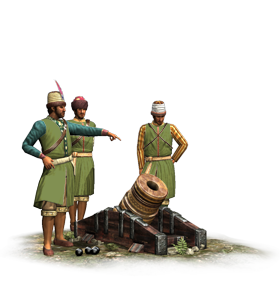Large Mortars (ETW Unit)
 A mortar is a large calibre, fixed artillery piece that lobs an explosive shell in a high arc at the enemy.
A mortar is a large calibre, fixed artillery piece that lobs an explosive shell in a high arc at the enemy.
Overview
To the uneducated eye, a mortar looks like a large, stumpy cooking pot, set at an angle in a heavy wooden frame. Indeed, the weapon’s name may even have come from its similarity to the mortars used to grind spices. Mortars use indirect fire, firing their shells high into the air to plunge down on enemy positions. This makes them ideal for use in siege warfare.
Unlike a howitzer, a mortar uses a fixed, and relatively small, charge of gunpowder to propel its shell. Range is adjusted by changing the angle of fire; accuracy is subject to winds and weather, thanks to the flight path. There is also a practical minimum range to mortar fire: no artilleryman is going to drop a shell so close that he will be caught in the blast. Their size, expressed in terms of the diameter of shell they fire, indicates their destructiveness.
Mortars have returned to favor with armies since the First World War. Modern designs, based on the British Stokes trench mortar, come in many sizes. Most can fire shells with proximity fuses as anti-personnel rounds. The larger examples can fire sophisticated “smart” munitions that guide themselves onto targets.
Tactics
Mortars are artillery with a greater range than cannons or howitzers. They also carry better firepower than 12-pounder howitzers. Unfortunately, they lack the ability to move, change angles to face different threats, and (unlike regular foot artillery) have a minimum range. They are made somewhat obsolete by 24-pounder howitzers, although they still possess a superior range to them.
